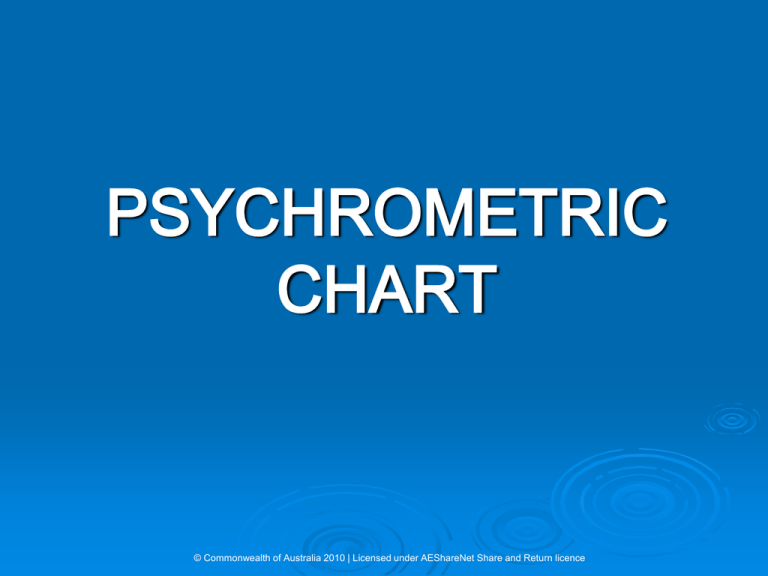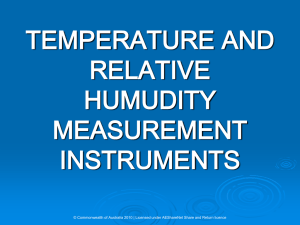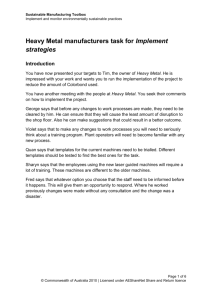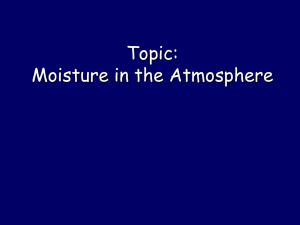AC26 Psychrometric Chart (PPT 2.0MB)
advertisement

PSYCHROMETRIC CHART © Commonwealth of Australia 2010 | Licensed under AEShareNet Share and Return licence Hello, I would like to show how to read a psychrometric chart. Rather than go through calculations every time we need some information about the properties of air, psychrometric charts have been devised to graphically represent the values of those properties. © Commonwealth of Australia 2010 | Licensed under AEShareNet Share and Return licence This is a typical psychrometric chart © Commonwealth of Australia 2010 | Licensed under AEShareNet Share and Return licence This skeleton chart shows the arrangement of the various lines and/or coordinates: 1. saturation temperature 2. dewpoint temperature 3. enthalpy 4. relative humidity 5. humidity ratio (moisture content) 6. wet bulb temperature 7. volume of mixture 8. dry bulb temperature. The chart is based on a standard barometric (atmospheric) pressure of 101.3 kPa or 760 mm Hg. © Commonwealth of Australia 2010 | Licensed under AEShareNet Share and Return licence The main coordinates of the average psychrometric chart are: saturation curve (100% RH) dry bulb temperature scale line (0% RH.) moisture content or humidity ratio scale. The dry bulb temperature lines run perpendicular to the base coordinate. Each line represents one degree of temperature change, with the scale ranging from -10 °C to 55 °C. © Commonwealth of Australia 2010 | Licensed under AEShareNet Share and Return licence The wet bulb temperature lines extend diagonally downward from the saturation curve at an approximate angle of 30° to the base line. Each line represents one degree of temperature change, with a scale ranging from 10 °C to 33 °C. The temperature scale is located on the saturation curve. © Commonwealth of Australia 2010 | Licensed under AEShareNet Share and Return licence The dew point temperature scale is the same scale as the wet bulb scale on the saturation curve. However, the dew point lines extend horizontally to the moisture content scale on the right of the chart. © Commonwealth of Australia 2010 | Licensed under AEShareNet Share and Return licence The relative humidity lines follow approximately the same curves as the saturation curve. The saturation curve is actually the line representing 100% relative humidity, with the dry bulb temperature scale line representing 0% relative humidity or dry air. © Commonwealth of Australia 2010 | Licensed under AEShareNet Share and Return licence The moisture content or humidity ratio lines are the same as the dew point temperature lines. However, the scale for the grams of moisture on the right of the chart is different and reads from 0 to 33 grams of moisture per kilogram of air. © Commonwealth of Australia 2010 | Licensed under AEShareNet Share and Return licence The specific volume lines run at a steep angle from top left to bottom right. The numerical values, along the bottom of the chart at the ends of these lines are given in cubic metres per kilogram of dry air and range from 0.75 to 0.95 m²/kg. © Commonwealth of Australia 2010 | Licensed under AEShareNet Share and Return licence Enthalpy is total heat content and is designated by the letter ‘h’. In psychrometric terms, enthalpy defines the heat quantity in the air and the moisture in the air. It is measured in kilojoules per kilogram of dry air. The enthalpy lines on a psychrometric chart are the same as the wet bulb lines. © Commonwealth of Australia 2010 | Licensed under AEShareNet Share and Return licence The enthalpy scale is located in convenient sections adjacent to the saturation temperature curve and ranges from −10 to 110 kJ/kg of dry air. The scale can be read by extending the wet bulb lines until they meet the scale. © Commonwealth of Australia 2010 | Licensed under AEShareNet Share and Return licence If the value of any two of the psychrometric properties is known, the value of any other property can be determined from the psychrometric chart. Normal practice is for the dry and wet bulb temperatures of a sample of air to be taken and then these temperatures are plotted on the chart. The two lines representing these temperatures will always cross at some point and this point then represents the condition of the air in the sample. Once this point has been determined, values for other properties can be identified. © Commonwealth of Australia 2010 | Licensed under AEShareNet Share and Return licence











